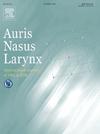Course of a sudden sensorineural hearing loss case diagnosed as intra-labyrinthine hemorrhage with MRI in the early phase
IF 1.5
4区 医学
Q2 OTORHINOLARYNGOLOGY
引用次数: 0
Abstract
Intralabyrinthine hemorrhage (ILH) is a rare differential diagnosis of sudden sensorineural hearing loss. Investigations using magnetic resonance imaging (MRI) in the early phase from the onset are inevitable to diagnose ILH. However, MRI is not usually performed during the early phases of sudden sensorineural hearing loss. Hence, ILH is rarely diagnosed, and the hearing prognosis and vestibular function in patients have been poorly understood.
In the present study, we report the detailed course of ILH with relatively good hearing recovery. Additionally, vestibular function recovery was quantitatively examined using a video head impulse test. A 75-year-old man presented at our clinic with a chief complaint of dizziness, sudden hearing loss, left sensorineural hearing loss, and nystagmus. MRI 18 days after onset showed a left ILH. Following treatment with prednisone, the patient's hearing level partially recovered and nystagmus disappeared.
Our experience emphasizes that MRI in the early phase is crucial for diagnosing ILH. Furthermore, MRI in the early phase should be considered in cases of sudden sensorineural hearing loss or dizziness and is beneficial for investigating ILH as a subpopulation of sudden sensorineural hearing loss.
1例早期MRI诊断为迷路内出血的突发性感音神经性听力损失病例的病程分析
甲状腺素内出血(ILH)是突发性感音神经性听力损失的罕见鉴别诊断。在发病早期使用磁共振成像(MRI)检查是诊断ILH不可避免的。然而,在突发性感音神经性听力损失的早期阶段,通常不进行MRI检查。因此,ILH很少被诊断出来,对患者的听力预后和前庭功能也知之甚少。在本研究中,我们报告了听力恢复较好的ILH的详细病程。此外,前庭功能恢复定量检查使用视频头脉冲试验。一名75岁男性以头晕、突发性听力损失、左感音神经性听力损失和眼球震颤为主诉来到我们的诊所。发病后18天MRI显示左侧ILH。经强的松治疗后,患者听力部分恢复,眼球震颤消失。我们的经验强调,早期MRI对诊断ILH至关重要。此外,在突发性感音神经性听力损失或头晕的病例中,应考虑早期的MRI检查,这有助于研究ILH作为突发性感音神经性听力损失的一个亚群。
本文章由计算机程序翻译,如有差异,请以英文原文为准。
求助全文
约1分钟内获得全文
求助全文
来源期刊

Auris Nasus Larynx
医学-耳鼻喉科学
CiteScore
3.40
自引率
5.90%
发文量
169
审稿时长
30 days
期刊介绍:
The international journal Auris Nasus Larynx provides the opportunity for rapid, carefully reviewed publications concerning the fundamental and clinical aspects of otorhinolaryngology and related fields. This includes otology, neurotology, bronchoesophagology, laryngology, rhinology, allergology, head and neck medicine and oncologic surgery, maxillofacial and plastic surgery, audiology, speech science.
Original papers, short communications and original case reports can be submitted. Reviews on recent developments are invited regularly and Letters to the Editor commenting on papers or any aspect of Auris Nasus Larynx are welcomed.
Founded in 1973 and previously published by the Society for Promotion of International Otorhinolaryngology, the journal is now the official English-language journal of the Oto-Rhino-Laryngological Society of Japan, Inc. The aim of its new international Editorial Board is to make Auris Nasus Larynx an international forum for high quality research and clinical sciences.
 求助内容:
求助内容: 应助结果提醒方式:
应助结果提醒方式:


